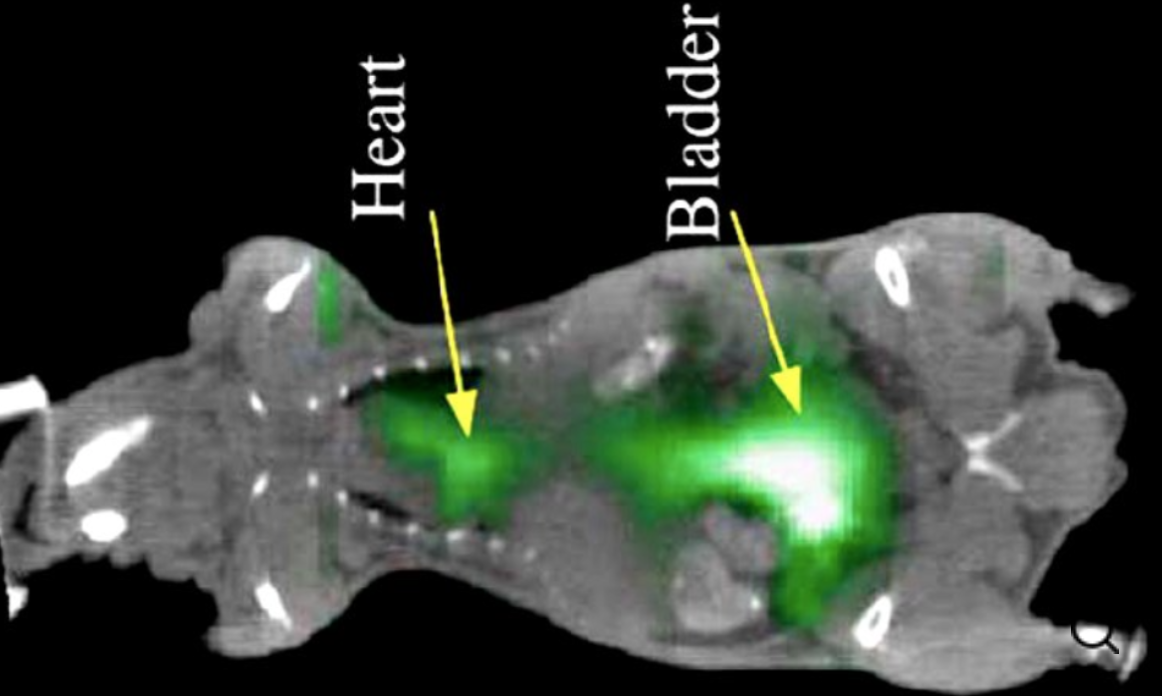D-Luciferin, sodium salt
CAS#:103404-75-7
Product Specifications:
D-Luciferin, Sodium Salt,
4,5-Dihydro-2-(6-hydroxy-2-benzothiazolyl)-4-thiazolecarboxylic acid sodium salt,
Formula: C11H7N2O3S2Na
MW: 302.30 g/mol
Color: Light yellow powder
Purity: >99% pure.
Storage/Handling: Store desiccated at -20°C. Protect from light.

Luciferin is a common bioluminescent reporter used for in vivo imaging of the expression of luciferase. This water soluble substrate for the firefly luciferase enzyme utilizes ATP and Mg2+ as cofactors to emit a characteristic yellow-green emission in the presence of oxygen, which shifts to red light in vivo at 37°C. Through the utilization of ATP, the reaction can be further used to indicate the presence of energy or life in order to function as a life-death stain.
Luciferin is a common reagent used throughout the biotechnology field and specifically for in vivo imaging. Luciferase labeled tumor cells, stem cells or infectious diseases are often inoculated into research animals such as rats or mice for investigation. The injection of luciferin allows for the real-time, noninvasive monitoring of disease progression and/or drug efficacy in these model systems through Bioluminescence Imaging (BLI).
Luciferin is also commonly used for in vitro research, including luciferase and ATP assays, gene reporter assays, high throughput sequencing and various contamination assays.

Preparation of Luciferin for In Vitro and In Vivo Bioluminescent Assays
Preparation of Luciferin for In Vitro Bioluminescent Assays
Materials: D-Luciferin Firefly, sodium salt, 1.0 g /vial; Sterile water; Complete media
Cells should be seeded in a plate overnight or several hours prior to assay to allow the cells to attach to the bottom. Suspension cell lines can be seeded in the working solution in the plate for direct incubation and imaging.
Doubling time should be considered for cell counting if doubling time is relatively short.
Procedure
Prepare a 200X Luciferin stock solution (30 mg/ml) in sterile water. Note: One can either reconstitute the entire 1.0 g of D-Luciferin in 33.3 mL of sterile water to make the 30 mg/mL (200x) stock solution, or reconstitute the quantity of D-Luciferin necessary for an individual experiment.
Mix gently by inversion until Luciferin is completely dissolved. *
Prepare a 150 µg/ml working solution of D-Luciferin in pre-warmed tissue culture medium. Quick thaw 200X stock solution of Luciferin and dilute 1:200 in complete media (150 µg/ml final concentration).
Aspirate media from cultured cells.
Add 1x Luciferin solution to cells just prior to imaging. Note: Incubating the cells for a short time at 37 °C before imaging can increase the signal. Incubation time is dependent on the specific cell type. Generally, a 10 min incubation is sufficient; test and adjust as needed.
Check the in vitro bioluminescence using the IVIS imaging system every 10 min, up to 40 min, to determine the kinetic curve and find the peak imaging time point for each cell type.
Preparation of Luciferin for In Vivo Bioluminescent Assays
Materials
D-Luciferin, Firefly, sodium salt, 1 g/vial
DPBS, w/o Mg2+ and Ca2+
Syringe filter, 0.2 um
Procedure
Prepare a fresh stock solution of Luciferin at 15mg/ml in DPBS. *
Filter sterilize through a 0.2 um filter.
Determine injection amount at 10 µL/g of body weight. Each mouse should receive 150 mg Luciferin/kg body weight. (e.g. For a 10 g mouse, inject 100 µL to deliver 1.5 mg of Luciferin.)
Inject the Luciferin intra-peritoneally (i.p.) 10-15 minutes before in vivo imaging, or as determined by kinetic curve. **
* Immediate use of working solution after dilution is strongly recommended. If necessary, dissolved luciferin may be stored at 4°C for up to 3 weeks; however prolonged storage at either 4°C or -20°C may result in degradation of signal.
** A Luciferin kinetic curve should be performed for each new animal model to determine peak signal time. Please see our ‘Determining the Luciferin Kinetic Curve for Your Model’ instruction sheet available for download on our website.
NOTE: Luciferin is a light sensitive reagent, and should be kept out of direct light as much as possible.
We recommend that the luciferin be protected from light (e.g. covered with a light blocking material such as tin foil) during the entire assay, from the stock solution preparation until completion of the procedure.
Safety warnings and precautions
NOTE: The qualified persons should always wear lab coats, gloves and goggles when working with our products although they are low-risk chemicals for R&D only.
| Name | D-Luciferin, sodium salt | ||
|---|---|---|---|
| CAT# | 12509-25mg;12509-100mg | CAS# | 103404-75-7 |
| Storage# | -20℃干燥避光 | Shelf Life# | 12个月 |
| Ex(nm)# | 328 | Em(nm)# | 533 |
| MW# | 302.3 | Solvent# | DMSO |
| Name | D-Luciferin, sodium salt |
|---|---|
| CAT# | 12509-25mg;12509-100mg |
| CAS# | 103404-75-7 |
| Storage# | -20℃干燥避光 |
| Shelf Life# | 12个月 |
| Ex(nm)# | 328 |
| Em(nm)# | 533 |
| MW# | 302.3 |
| Solvent# | DMSO |


 Specification
Specification Support
Support



